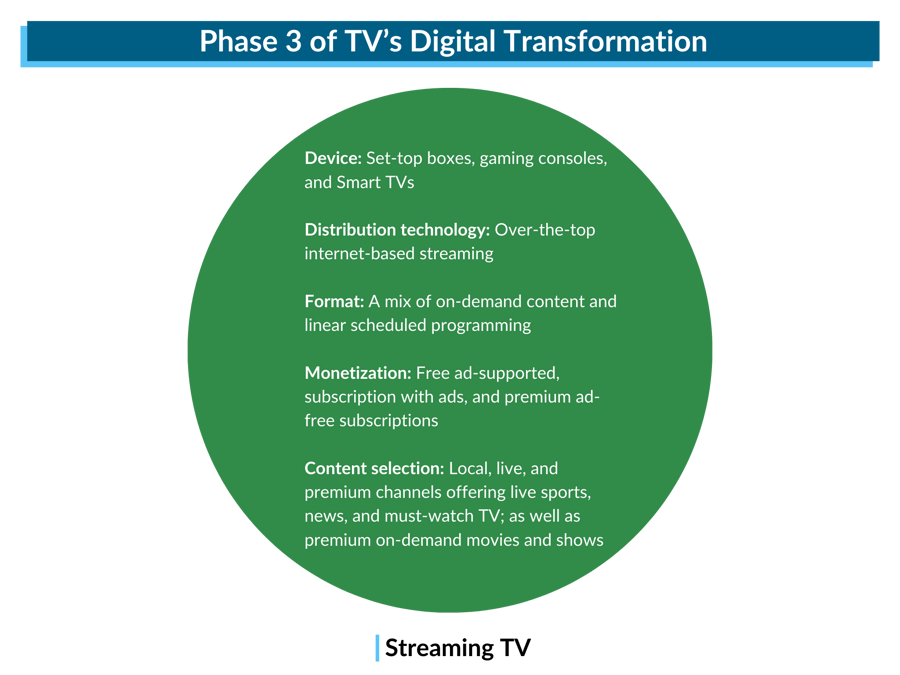- Home
- Strategus Blog
- The Future of TV: How Advertisers Can Prepare for a Converged Landscape
The Future of TV: How Advertisers Can Prepare for a Converged Landscape
 Traci Ruether
Traci Ruether
11 minutes read

Here’s an exercise: Try to count the number of ways you consume TV each day. I’ll go first.
I start my morning with the local news while packing my toddlers’ lunchboxes. Because my husband insists on keeping our cable bundle, I tune in the old-school way.
Most of my workday is spent doing various tasks on my MacBook, although sometimes I’ll sneak in a lunchtime run while streaming a mindless series like Love Is Blind on Netflix.
Once my kids are home from preschool, I’ll let them pick a show to stay busy while I cook dinner. They’ve had the luxury of on-demand entertainment for their entire lives and often opt for something like Miss Rachel on YouTube or Paw Patrol on Pluto TV.
Next comes bedtime, after which my husband and I turn on something more age-appropriate. Our current lineup includes Fallout on Amazon Prime, Top Chef on our Cable DVR, and Last Week Tonight With John Oliver on Max.
The takeaway of all this? TV consumption has become a juggling act — and so has TV advertising.
Both traditional broadcast and streaming services compete for eyeballs, with the average U.S. household subscribing to four paid streaming services at a time. Free platforms like YouTube and Tubi are also a mainstay in most homes, further saturating the landscape.
This has resulted in media fragmentation, with countless siloed vendors vying for ad dollars. As a result, advertisers looking to reach viewers across disparate environments are often overwhelmed and unprepared for what will come next.
In this guide to the future of TV, we explore the evolution of television advertising, predictions from media insiders, and how marketers can take a unified approach across linear and connected TV (TV) advertising.
Keep reading to learn what it takes to thrive in the evolving world of television.
TV’s Evolution: The Past, Present, and Future

The digitalization of TV is nothing new. Most of us upgraded to Smart TVs several years ago and have been watching a mix of traditional broadcasts and streaming for some time. But the impact on advertisers wasn’t as immediate.
Why? Subscription video on demand (SVOD) was the primary model when Netflix first launched, meaning ad dollars were still relegated to linear TV. Prime-time events like live sports also took a while to move to streaming, which slowed cord-cutting.
So where are we currently, and what comes next? Here’s a look at the evolution.
2005–2013:
Streaming Compliments Traditional Broadcast TV
In the early days of streaming, services like Netflix didn’t directly compete with legacy media companies. In fact, prior to COVID, most legacy media companies happily licensed their content to Netflix.
Was there disruption? Of course. But consumers saw these streaming services as a way to watch ad-free content on their own time.
The promise of subscription-based streaming services was simple: They provided viewers with access to a library of exclusive shows and movies that could be watched anywhere and anytime. Only Hulu included ads at this early stage of the game, and linear streaming channels weren’t even a thing until virtual multichannel video programming distributors (vMVPDs) like Sling TV entered the picture.
As such, most consumers held on to their cable packages as a way to watch local news and live sports broadcasts. The desire to lean back for scheduled programming or surf between channels also remained strong, which is why legacy TV maintained its unique appeal.

2013–2030:
Streaming Services Mature, Introducing Fragmentation and Overlap
A new era began in 2013 when Netflix started releasing original scripted content. Shows like House of Cards and Orange Is the New Black set off an arms race.
‘Streaming’ suddenly transformed from a convenient way to watch reruns to an exclusive means for accessing the most-talked-about new series. As such, Amazon Prime, Apple TV+, Disney+, and more set their sights on a new target: luring in new subscribers with must-watch originals.
From there, the distinction between legacy TV and streaming began to disappear — bringing us to where we are today.
The format, content selection, and devices used to watch TV content are now identical across both categories. More specifically:
- 90% of homes have an internet-connected TV, which can be used to view both over-the-air and over-the-top content.
- Services like YouTube TV and Tubi offer a blend of linear programming and on-demand content.
- Several streaming services hold exclusive rights to major sporting events today, prompting viewers once slow to make the move to cut the cord in earnest.
Eyevinn Technology’s Magnus Svensson explains:
“As streaming starts to look more like TV, it shows they're learning from each other. The future of watching shows and movies is probably going to be a mix of the old and the new, taking the reliable parts of TV and mixing them with the cool new things streaming can do. This way, viewers get more of what they want, how they want it, in a modern way.”
The TL;DR is that viewers today are hybrid, tuning into a mix of broadcast and streaming platforms. This requires advertisers to take a similarly hybrid approach. And yet, most are dragging their feet.
"There remains a significant gap between viewership and ad dollars on TV streaming. In 2023, U.S. adults aged 18-49 spent more than 60% of their TV time on streaming, while advertisers spent just 29% of their TV budgets on streaming."
Adapting to this reality won’t just make advertisers more successful today — it will also prepare them for what’s to come.

2030 and Beyond:
The Total Convergence of Traditional and Streaming TV
The convergence of traditional broadcast and streaming will continue. Eventually, CTV will combine the best of the streaming and legacy broadcast models — giving viewers flexibility without complexity.
Bill Condon, the VP of Global Distribution at Xumo elaborates:
“What we’re doing right now is a dress rehearsal for when we move everything to IP delivery. I don’t have a crystal ball to tell you when that will happen, but it’s something we should all strive for.”
And if this transformation is done right, the fragmentation that’s frustrated viewers and advertisers for so long should fade into the background. The result? A more cohesive experience for both parties, a better user experience for viewers, and higher performing campaigns for marketers.
But reaching this ideal future state requires collaboration across the industry. Strategus President Todd Porch explains:
“Technology has never moved as fast as it is today in the media space. And it will never move this slowly ever again.
There’s convergence, the marketplace is a bit fractured, and from a leadership standpoint, the onus is on those of us in the industry to drive simplicity and smooth over the fractures.”
So where do the fractures exist and how can advertisers adapt their strategy to account for the current state of television while preparing for the future?
It all starts with prioritizing several key capabilities.

Capabilities for Advertisers Navigating Today’s Fragmented Landscape
The first step in preparing for the future is to embrace the present. Any actions that advertisers can take to focus on the viewers rather than the networks and apps where their ads run are paramount to this end.
From there, tools for controlling the viewer experience, executing cross-channel strategies, holistically measuring campaign performance, and connecting the dots between digital and non-digital channels will alleviate some of the discontinuity.
1. Content-Agnostic Media Buying
The old way of TV advertising forced media buyers to take a content-specific approach to campaign planning. Rather than targeting ads to relevant buyers with nuanced messaging, advertisers delivered generic commercials to broad audiences.
With programmatic CTV advertising, ads are placed based on the viewers themselves (and not the individual publishers). This opens up the doors to customize ads based on who sees them and where they are in the buyer’s journey.
But to get the most out of the targeting possibilities of programmatic CTV, you need access to a wide array of publishers and data partners. As long as you’re tied to a single platform, you’ll be limited in what you can achieve.
We’d recommend finding a vendor-agnostic solution that integrates data and inventory from a large network of partners. That way, you’ll gain the agility to customize your campaigns based on marketing needs and deliver personalized solutions that drive results.
2. Frequency Management Across Linear and CTV
Agencies and brands must approach CTV and linear in a complementary way. Both mediums are relevant today, with viewers seamlessly navigating between the two. Advertisers must therefore follow suit.
To bridge the gap, look for CTV providers with advanced targeting capabilities to ensure that viewers already exposed to your linear ads aren’t also getting bombarded on streaming platforms. Frequency control measures will help reach viewers, at the right time, and with the right frequency — without causing ad fatigue.
3. Ad Retargeting Across Other Digital Channels

We’ve already established that a siloed approach doesn’t cut it. Consumers seamlessly navigate between various channels, and your advertising strategy should follow suit. But this doesn’t just apply to linear TV and CTV. Creating an integrated brand experience should be the guiding light for all of your marketing efforts.
Enter CTV retargeting.
While traditional TV ad campaigns traditional TV ad campaigns offer limited insight into which viewers see a given commercial, connected TV ads provide the data required to take an omnichannel approach.
At Strategus, we develop cross-device campaigns that re-engage viewers who’ve been exposed to a CTV ad across supplementary channels. For instance, we might run ads for a law firm on their target viewers’ living room TV, and then re-engage these same viewers with additional online video, display, and/or streaming audio ads.
This gives brands and agencies a way to deliver the best message at each touchpoint — and create cohesive omnichannel experiences that increase engagement and drive conversions.
Check out The Complete Guide to CTV Retargeting:
4. Multi-Channel Attribution
Measuring the effectiveness of traditional TV ads is a guessing game. As such, the goal of TV advertising has often been to drive brand awareness rather than convert actual customers.
But while TV ads are more of a top-of-funnel play, that doesn’t mean they shouldn’t be linked to actual results. With CTV advertising, it’s possible to connect the dots across all touchpoints by tracking user activity following ad exposure.
This type of visibility into the buyer’s journey isn’t just essential to quantify ROI, it also provides the insight needed to optimize future efforts.
With the right attribution tools, you can link TV exposures to tangible results like:
- Foot traffic
- Post-view website visits
- Online purchases
- Search and social activity
- And more
And for this, you’ll need advanced, multi-touch attribution like what we provide at Strategus.
5. Holistic Measurement and Publisher Data Transparency
In a perfect world, you’d have all your TV advertising efforts consolidated onto a single reporting dashboard. We’re not quite there yet. But finding a provider that offers 24/7 reporting for your CTV efforts is a great place to start. 
Holistic measurement is essential for understanding campaign effectiveness in today’s fragmented environment. Moreover, publisher data transparency is key to ensuring ads reach the right audiences in the right environments.
Advertisers need to know where their ads are running and how they perform across the entire ecosystem. Transparent reporting eliminates the "black box" effect, providing actionable insights for refining targeting strategies and optimizing campaigns.
At Strategus, we believe that transparency is the foundation of effective advertising — enabling advertisers to make data-driven decisions that drive business growth. For this reason, our reporting dashboard offers dynamic insights into campaign performance, from impressions and video completion rates to conversions and attribution.
Request a demo of our reporting dashboard.
Conclusion
It’s not a question of if linear and CTV advertising will converge. Rather, it’s a question of when. And while it’s impossible to nail down a timeline, there’s plenty that advertisers can do now to prepare.
The future of TV is about giving viewers what they want, where they want, and how they want it. It's a blend of old-school reliability and new-school flexibility.
By embracing a viewer-centric approach and utilizing the right tools, advertisers can navigate today’s disjointed landscape and thrive in this exciting new era of television.
At Strategus, we team up with brands and agencies to simplify CTV advertising and drive better performance. Our partner ecosystem integrates countless ad exchanges, SSPs, DSPs, publishers, and data providers to ensure precision targeting at scale. What’s more, we take a hands-on approach — providing the expertise and resources needed to make the most out of your investment.
So what are you waiting for? Start preparing for the future today by contacting us.

Traci Ruether is a content marketing consultant specializing in video tech. With over a decade of experience leading content strategy, she takes a metrics-driven approach to storytelling that drives traffic to her clients' websites. Follow her on LinkedIn or learn more at traciruether.com.
Strategus is a managed services connected TV(CTV) advertising agency with over 60,000+ campaigns delivered. Find out how our experts can extend your team and drive the result that matter most.
Talk to an Expert
Table of Contents
-
TV’s Evolution: The Past, Present, and Future
-
2005–2013: Streaming Compliments Traditional Broadcast TV
-
2013–2030: Streaming Services Mature, Introducing Fragmentation and Overlap
- 2030 and Beyond:The Total Convergence of Traditional and Streaming TV
- Capabilities for Advertisers Navigating Today’s Fragmented Landscape
Seeking a Custom CTV Strategy That Delivers?
What to read next

Best SVOD Platforms for Advertisers
The streaming wars have a new battlefront, and this time, it's all about your ad budget. Just a few years ago, SVOD meant "no commercials." Now, it...
12 minutes read

Third-Party Data Targeting for CTV: Benefits & Tactics
Third-party data. It’s a term that’s thrown around, and yet few take the time to detail its pros and cons — much less strategies for using...
7 minutes read

First-Party Data Targeting: Benefits and Tactics for CTV Advertising
First-party data is the information that companies collect directly from their customers rather than through intermediaries. Advertisers use this...
10 minutes read

Foot-Traffic Attribution: Tying Ad Impressions to In-Store Visits
The marketing funnel has changed. Today’s shoppers often begin researching products from the comfort of their homes and don’t set foot into a store...
8 minutes read
















